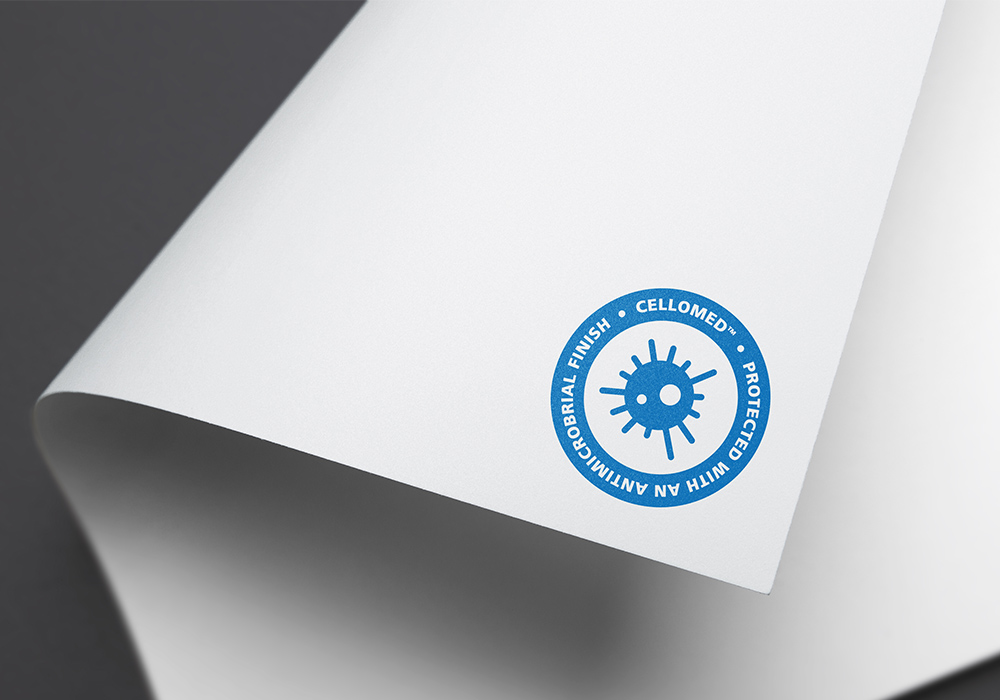May 7 Celloglas News
Introducing Cellomed: How print can reduce the spread of bacteria

Businesses have a duty of care and many within the print and packaging industry are looking at improved measures to keep customers, staff and the wider public safe. Germs are invisible to the naked eye but there are ways to fight bacteria and prevent its spread in the everyday items we touch. According to the Centres for Disease Control and Prevention (CDC), 80% of illness-causing germs are transferred by touch alone. Bacteria can be carried on printed matter – particularly in hospitals, schools and restaurants – but we have the capability to limit and even prevent the transfer of any bacteria in certain environments and industries.
Here, we discuss the value of antimicrobial print and consider what the industry can do to help fight the spread of bacteria and ensure printed material remains as safe as possible for its readers.
What is Cellomed?
Celloglas is at the forefront of innovation and this groundbreaking product reduces the risk of cross-contamination and prevents bacterial build-up on print. It could prove game-changing for many industries whose printed matter receives high volumes of traffic and is frequently touched by many different people.
Cellomed is a range of coatings and laminates applied to paper and board to provide life-long antimicrobial protection. It is ideal for the food industry and hospitality – menus will benefit from Cellomed – as well as all industries publishing magazines and in-flight literature (or that on any transport). A little more about the range:
Cellomed coatings and varnishes. Available in a gloss, matt, neutral or soft-touch finish, these coating are perfect for print where durability isn’t a priority as much it being antimicrobial.
Cellomed laminates. In a gloss or matt finish, our laminate is highly recommended where durability is required as well as antimicrobial properties. The film has an antimicrobial coating applied to the face to offer long-lasting protection against a range of bacteria.
How does Cellomed work?
This innovative product is based on silver, which is its key ingredient. As we know, bacteria move around and land on surfaces – and it can remain there for a long time, meaning print could be a threat to our health if the right protection isn’t used. With Cellomed coatings and laminates, silver particles feature on the substrate and they are ready to act and attack the bacteria. Silver ruptures the bacterial cell membrane, immobilises the bacteria by draining it of oxygen and destroys the reproductive receptor.
Why silver?
Silver has long been used extensively in the healthcare setting to reduce levels of bacteria and improve infection control. From equipment and medicines to wound care like bandages, silver-treated items are hugely effective fighting against a range of micro-organisms. Silver has proven success with activity against resistant strains of bacteria such as MRSA.
Silver-based products offer a number of advantages. Silver is natural and sustainable – it’s great for water-based materials – and products have low minimum inhibition concentration (MIC), which is the level at which a material becomes effective against microbes. Some non-silver materials will eventually allow bacteria to develop resistance if they receive widespread usage over a long period – silver doesn’t.
What’s more, it works invisibly without changing the look, feel and colour of the print – and it’s safe for the environment.
Cellomed’s high performance has been tested under the most stringent conditions against a wide range of microbes, including bacteria, fungi and other allergens. Download Cellomed’s credentials to find out more about its antimicrobial properties.
Alternatively, contact us to discuss ways in which your print can become as safe as possible for anyone handling it.

